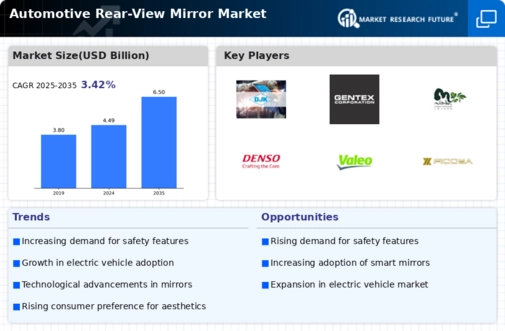Top Industry Leaders in the Automotive Rear View Mirror Market
The Automotive Rearview Mirror Market: An Exploration of Competitive Dynamics
The unassuming rearview mirror, once a static fixture, now undergoes a profound transformation fueled by the pursuit of heightened safety, convenience, and connectivity. Today, the global automotive rearview mirror market represents a vibrant arena where industry stalwarts and nimble innovators vie for dominance, each crafting solutions that extend beyond simple reflection. Let's delve into the pivotal strategies, decisive factors, and emerging trends shaping this ever-evolving landscape.
Strategic Approaches of Key Players:
Product Expansion: Leaders such as Gentex and Magna International are broadening their offerings beyond conventional glass mirrors. They introduce electrochromic mirrors that automatically dim headlights, frameless designs for enhanced aesthetics, and digital rearview mirrors (DRMs) providing wider viewing angles and integrating blind-spot detection cameras.
Technological Advancements: Innovation propels this market forward. Start-ups like Rear View Inc. disrupt the landscape with rearview mirror displays seamlessly integrating augmented reality (AR) navigation and parking assistance features. This leap in technology expands functionality, enticing early adopters.
Partnership Ecosystem: Acknowledging the complexities of electronics integration, major players like Valeo forge strategic alliances with tech giants like Samsung and software specialists like Mobileye. These collaborations accelerate the development and market penetration of advanced rearview solutions.
Regional Focus and Compliance: Market dynamics and regulations vary significantly across geographies. Gentex caters to North America's demand for advanced driver-assistance features with their HomeLink® garage door opener integration within the mirror. Meanwhile, Saint-Gobain addresses Europe's stringent safety regulations with breakaway mirrors designed for pedestrian protection.
Factors Influencing Market Share:
Technology Performance and Reliability: The effectiveness of DRMs and integrated features relies on screen resolution, image quality, and seamless vehicle system integration. Players like Denso stand out with high-definition OLED displays and lag-free performance, providing a clear and dependable rearview experience.
Affordability and Cost-effectiveness: Despite the appeal of advanced features, cost remains a critical factor. Companies like Magna International develop cost-efficient DRMs using software-based functionalities and modular designs, ensuring accessibility across various car models and price segments.
Safety and Driver Comfort: Rearview solutions must enhance blind-spot visibility, minimize glare, and reduce driver fatigue. Magna International integrates night vision technology into their mirrors, enabling safe driving in low-light conditions. These safety and comfort features serve as major differentiators.
Customization and Connectivity: Personalization gains traction, with Gentex offering automakers the ability to customize mirror displays with brand logos and information displays. Meanwhile, Bosch integrates smartphone connectivity and internet browsing capabilities, blurring the line between the mirror and an infotainment hub.
Emerging Trends:
Heads-up Displays (HUDs): Continental leads in this technology, projecting driver information onto the windshield through the mirror, potentially improving reaction times and reducing eye strain.
Voice-activated Control: Faurecia pioneers voice commands for adjusting mirror settings and accessing connected features, adding convenience by enabling drivers to control their rearview experience without taking their hands off the wheel.
Biometric Authentication and Security: Companies like Hyundai Mobis explore integrating fingerprint scanners or facial recognition into mirrors, potentially adding a layer of security and convenience for future vehicles.
Competitive Landscape Overview:
The automotive rearview mirror market is a dynamic realm driven by technological advancements, the pursuit of enhanced safety and comfort, and the increasing connectivity of vehicles. Established players with diverse product portfolios, technological prowess, and global reach hold a competitive edge. Yet, disruptive innovations from start-ups and the focus on advanced functionalities constantly reshape the landscape. To thrive, players must prioritize cutting-edge technology, affordability, regionalization, and partnerships. Integration of AR, HUDs, voice control, and security features will be crucial differentiators. Those who swiftly adapt, navigate regulatory complexities, and offer reliable, cost-effective solutions improving the overall driving experience will secure a clear reflection of success in this evolving race.
Recent Industry Developments:
Ficosa International S.A. (Spain): Announced collaboration with Magna International to develop a mirrorless camera system for commercial vehicles.
Magna International Inc. (Canada): Showcased a prototype rear-view mirror displaying augmented reality information on the windshield.
Burco Inc. (U.S.): Released a new line of aftermarket rear-view mirrors with wireless phone charging capabilities.
Valeo SA (France): Announced plans to invest €100 million in the development of advanced driver-assistance systems, including camera-based rear-view mirrors.
Lumax Automotive Systems Ltd (India): Launched a new line of rear-view mirrors with automatic dimming and lane departure warning features.
Leading Companies in the Automotive Rearview Mirror Industry:
- FLABEG Holding GmbH (Germany)
- Ficosa International S.A. (Spain)
- Magna International Inc. (Canada)
- Gentex Corporation (U.S.)
- SL Corporation (South Korea)
- Burco Inc. (U.S.)
- Valeo SA (France)
- Lumax Automotive Systems Ltd (India)
- Honda Lock Manufacturing (Japan)
- Ichikoh Industries Ltd. (Japan)
- Murakami Corporation (Japan)
- And others

